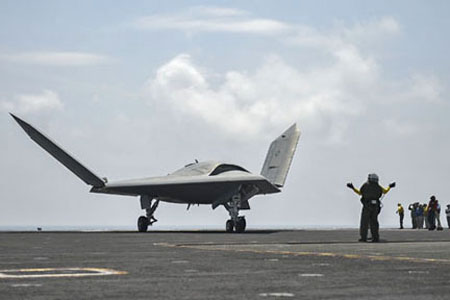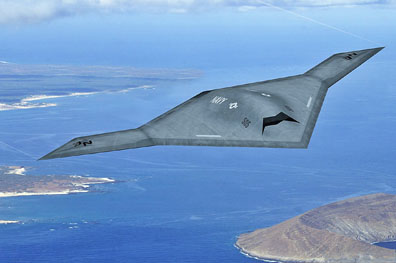In 2013 the Navy’s X-47B UCAS (Unmanned Combat Air System) became the first pilotless, semi-autonomous aircraft to take off and land from a carrier all by itself. The craft isn’t new — it’s been around since 2011 — and it’s not altogether autonomous, but one look in his eyes and you know fully autonomous is coming soon. Especially after a carrier landing the craft backs up to release its tail hook, and then folds its wings up and trundles off to a quiet corner of the busy flight deck — all by itself.

The 38-ft long X-47B is controlled by humans using keyboard commands and mouse clicks. The operator tells it to go to a certain point on the map, and the X-47B pilots itself there. This to me is autonomous. It does so at high-sub-sonic speed and with a range of 2,100+ NM. And, it can even do an in-flight refuel all by itself — well, with a bit of help from a tanker plane. There are two of the experimental X-47Bs and they are actually going to be retired soon to a nice quiet museum someplace. The next generation will need a lot of situational awareness to really operate completely on its own, but that is coming.
Autonomous will change aircraft carrier operations drastically and that may happen really soon. I say “may” happen soon only because, well, you know, it’s the government. The technology is either ready or darn close. Some interesting design work is going on in that area right now, no doubt.

The Predator and Reaper military drones we hear about all the time are remotely piloted vehicles (RPVs) — piloted by humans with hands on a control stick. Drones, UAVs, and RPVs are all significant but they are not autonomous — not robotic — they are being controlled by a person in real-time. Take a look at Paul O’Shea’s article in this area of a few weeks ago (http://goo.gl/bhOFXx).
There’s a lot of talk about autonomous cars, but autonomous taxis may come sooner and be even more significant. A smart intelligent taxi could inexpensively, and very safely, take us around a downtown — maybe in a downtown where regular cars are not even allowed. It’s ironic that these vehicles may replace on-demand ridesharing services like Uber and Lyft, right after they nearly replace the taxi.
Automobiles are, of course, inching up on autonomous with active cruise control. One big step that should be straight-forward is what we can call active crash prevention. A few times a year we read or hear about someone (often an older person) who crashes their car into the front window of the drycleaners shop down the street. Thought they were pushing on the brake, but it was actually the accelerator pedal. A front camera/radar should be able to prevent that dangerous mishap. Will it prevent all front-end crashes? Probably not, but it could stop the simpler ones and it wouldn’t cost much. Let’s make it standard equipment. Soon.
Autonomous is the next big thing. If you’re working on autonomous vehicles of any kind, give us a comment and let us know what kind of challenges you’re facing.
Advertisement
Learn more about Electronic Products Magazine





